Changing the MENtality: University of Akron contributes to bridging gender gap in nursing
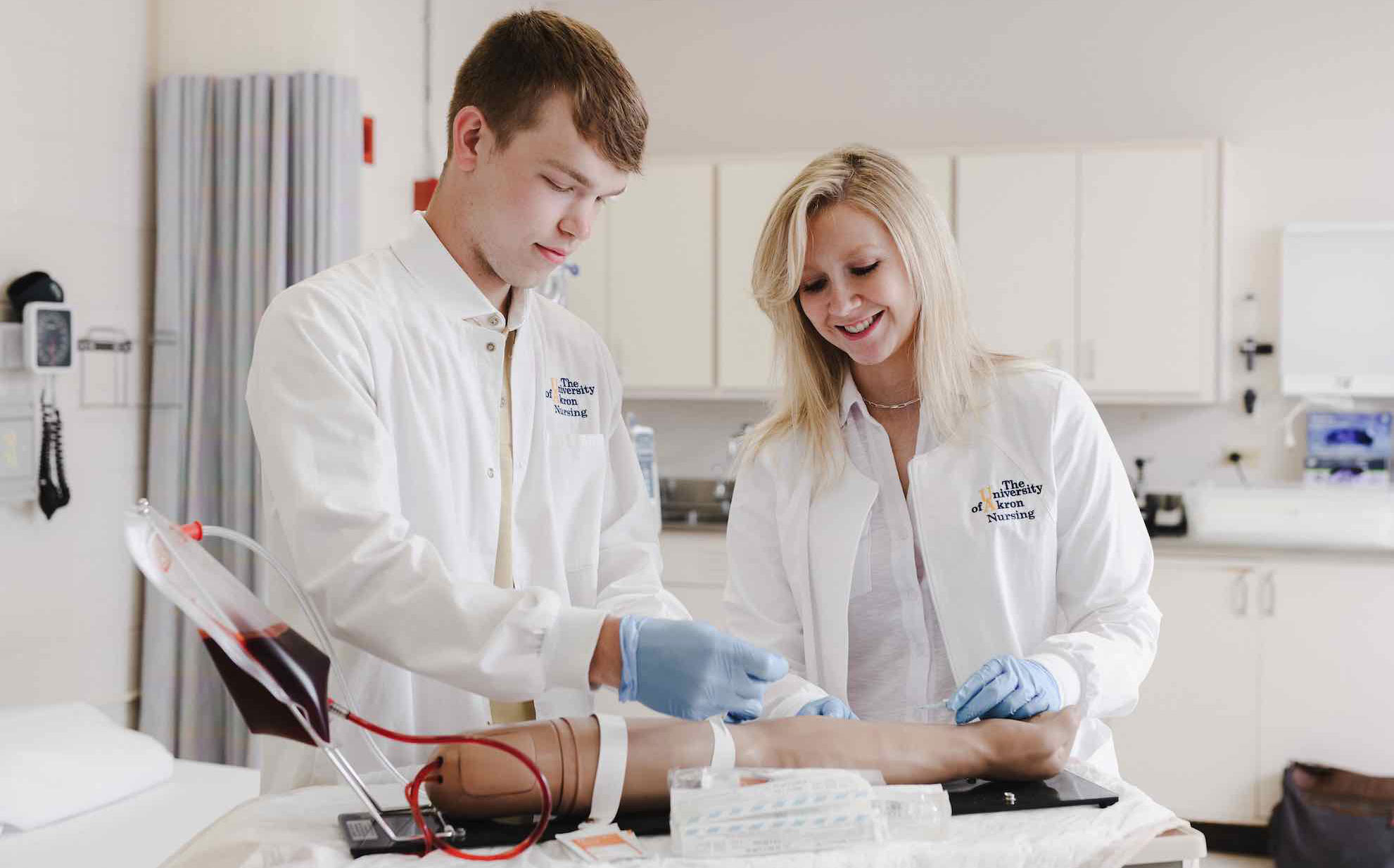
By the time he was just a couple feet tall, then-youngster Andrew Kochan ’14, ’19 was already no stranger to children’s hospitals. Throughout his youth, the Uniontown, Ohio, native experienced a total of 10 surgeries, with his first few occurring by the time he was just over a year old.
Vulnerable moments like that can leave a lasting impression on a child. But in Kochan’s case, it was rather serendipitous. Ultimately, the experiences influenced him to pay it forward by knowing at a young age that he wanted to be the people who comforted him — nurses.
“One of my only memories as a small child is actually right before I fell asleep under anesthesia for one of my surgeries when I was maybe two-and-a-half to three years old,” Kochan recalls. “It was a very powerful experience because I can’t think of a time when I was more scared than an adult putting a mask over my face and telling me everything is fine.”
That “powerful experience” made Kochan who he is today. After graduating from The University of Akron (UA) with a Bachelor of Science in Nursing in 2014, and later a Master of Science in Nursing in 2019, Kochan is now a certified registered nurse anesthetist (CRNA) at Akron Children’s Hospital, where he is one among 118 male registered and advanced practice nurses — out of a total of 2,253.
“What that childhood experience with the nurse anesthetist provided for me was an insight into how crucial it is to empathize and be compassionate,” Kochan said. “I’m living the dream. I ended up exactly where I belong – providing anesthesia at Akron Children’s Hospital.”
Male nurses on the rise
Today, Kochan is one of the 3.2 million registered nurses working in the profession, in which male nurses are on the rise. According to the U.S. Bureau of Labor Statistics (BLS), 13.3% of registered nurses (RNs) in 2021 were men, up from 7% in 2008. Males included, BLS projects registered nursing jobs to grow 6% from 2021 to 2031.
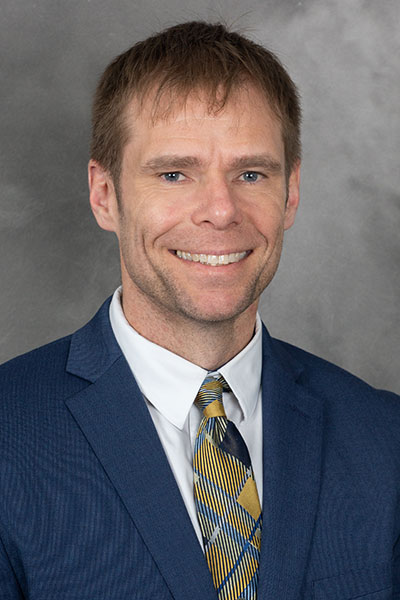
Dr. Tim Meyers
One of the reasons considered why not as many men have entered the nursing profession could be because of the waning stereotype that nursing is a job meant for caring, compassionate females and maybe not a respectable career for a man from direct or indirect peer pressure. But that shouldn’t stop anyone from wanting to be a nurse, said Dr. Tim Meyers, executive director of UA’s School of Nursing.
“I think that young men need to be confident in themselves, and if society has a different spin to their self-identity, be OK with that,” Meyers said. “I hunt, I drive a truck, I have a motorcycle — all things that might seem like male stereotypes. But nothing invigorates the compassion and care in me more than walking into a room and holding a patient’s hand or crying with them. And that’s OK for a guy to cry and be more of a human than what society wants us to be. We’re different now, and it’s OK to be a guy in nursing and have that caring aspect.”
Even at UA, male nursing students are on the rise. In fact, males made up just 9% of the student population in 2017. Today, across all undergraduate and graduate programs, male students make up 20% of the School of Nursing’s student body.
“Nursing is an excellent career choice for anyone who is a critical thinker and has a passion for supporting others at their worst and helping them get back to their best,” said Jason Grassie (Tallmadge, Ohio), a fourth-year nursing student. “I’ve known since I was young that I wanted to be active and on my feet at my job. I haven’t met a person who wasn’t supportive of my decision. I’ve been told by everybody that nursing is a challenging but rewarding and an ever-growing field.”
A first for a family
The motives people have for a career in nursing can vary, from following in the family footsteps to being influenced by a life experience to wanting a completely new profession. But one constant exists for many, like Grassie — support for their realization of what they want to do for their careers.
For Ryan Wells ’10, ’19, nursing took a long time to become a career contender. Today, Wells, also from Uniontown, works alongside Kochan as a CRNA at Akron Children’s Hospital.
“Nursing was not my first major, nor was it second, third, fourth, fifth, sixth, seventh or eighth,” Wells joked.
Even in high school, an aptitude test suggested he’d be great at nursing, but he didn’t want to pursue it partly because of the gender imbalance in the profession and feeling pressured into doing it.
“I pushed back on that and tried a number of other majors, from engineering majors to language and business majors,” Wells said. “It wasn’t until I got a job as a nurse tech in an emergency department that, after a couple days of that job, I was like, ‘this is it; this is where I want to be.’ I was going to be the first health care professional in [my] entire family. Even to this day, none of my family is in health care.”
Eventually, after making that ninth or 10th change in majors, Wells earned his Bachelor of Science in Nursing from UA in 2010 and his Master of Science in Nursing in 2019.
Meyers, executive director of the School of Nursing, shared a similar experience, having changed his major in college at least seven times after trying programs like chemistry and education. And rather than focusing on the physiological aspect of health care, like what a medical doctor would do, Meyers wanted to impact the social aspects of caring for patients.
“That’s where I get goosebumps,” Meyers said. “That’s the art of nursing — seeing how health affects a patient socially or psychologically and helping them get through that adjustment.”
For Kochan, his interest in nursing at a young age continued into high school, where he wanted to know more about what nurses do. So, he started volunteering at Akron Children’s Hospital and saw what they did daily, and he even played games with kids to take their minds off being in a hospital.
“Through that experience, I was able to see firsthand what nursing actually means,” he said. “I really admired what the nurses were doing at the bedside [and] struck home for me that that was where I was going to end up.”
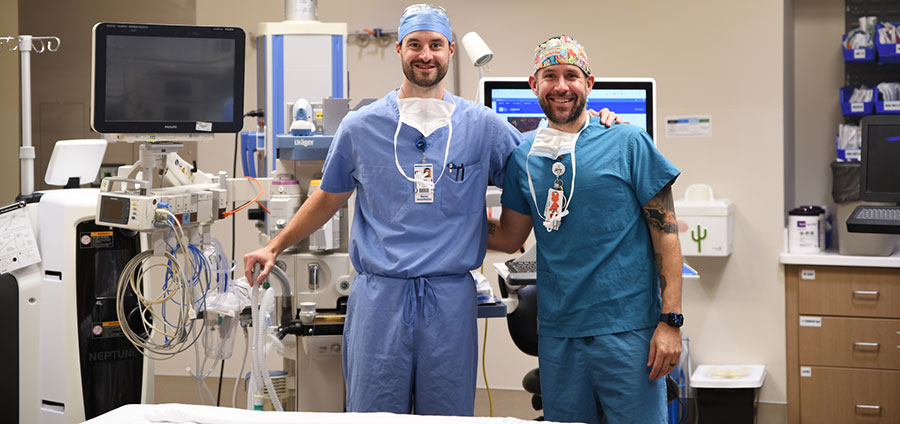
Andrew Kochan (left) and Ryan Wells (right) both graduated from The University of Akron with both their bachelor’s and master’s degrees in nursing. Today, the alumni are certified registered nurse anesthetists at Akron Children’s Hospital.
Like Kochan, fourth-year UA nursing student Kyle Samec (Painesville, Ohio) went through an experience — kidney surgery at age 12 — that influenced his decision to go into nursing.
“It was a pretty major procedure, and I was understandingly terrified,” Samec recalled. “But my experiences with the nurses at the hospital who helped reassure me that I was going to be OK and were so friendly and caring made a huge impact on me. I want to make others feel the way I did when they are going through similar tough situations with their health and be a part of their recovery. Everyone that I told about wanting to become a nurse was very supportive and believed I was going into a very respected profession, which made the decision for me to become one even easier.”
More than 50 years of nursing excellence
As a top school for nursing in Ohio, founded in 1967, UA’s School of Nursing is dedicated to the belief that nurses are the backbone of today’s health care system. And the School is dedicated to training and empowering the next generation of transformational, innovative medical leaders through partnerships with nationally recognized hospital networks nearby, stellar faculty and great hands-on learning.
In fact, UA’s undergraduate and graduate programs consistently have strong pass rates on national certification exams, including the nurse anesthesia program that Kochan and Wells completed. Their class of first-time candidates received a 100% pass rate on the rigorous CRNA national certification exam in 2019. That trend continues today, where the Class of 2022 earned a 100% first-time pass rate. For perspective, the national first-time pass rate in 2021 was 84.1%, according to the most recent data by the National Board of Certification and Recertification for Nurse Anesthetists.
For current students Grassie and Samec, they find that there’s an element of flexibility and a path to rewarding careers through UA’s program.
Samec is a student in the online RN-BSN program, which is designed for registered nurses who wish to earn the rest of the credits required for a Bachelor of Science in Nursing (BSN). The program also offers a pathway for continuing to a Master of Science in Nursing. An in-person program is also available. UA’s expert nursing faculty are supportive of students as they navigate the many current challenges facing registered nurses, preparing them for greater success in their careers in an increasingly complex health care system.
“I would describe being a nursing student at UA as very flexible and overall positive,” said Samec. “Because I take only two classes a semester, it’s a little more relaxed, which I need since I also work full-time as a nurse and have a family.”
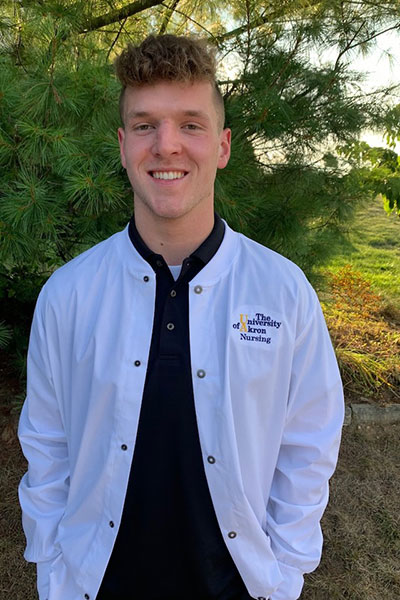
Jason Grassie
Grassie, who is in the traditional Bachelor of Nursing program, feels that being a nursing student can be challenging with difficult coursework, but there’s a huge benefit at the end of it all.
“It is very rewarding and promising because you know when it’s all said and done, you will have a degree in a field that is extremely fulfilling and will open many doors for opportunity,” Grassie said. “The nursing program has brought me friendships that will last a lifetime.”
Through it all, the program makes its students ready to enter the workforce and begin their careers as health care professionals or lay a path for advanced learning — even before they graduate with their degrees. UA nursing students are often heavily recruited for jobs usually six months before they earn their degrees.
“My experience, having graduated in 2014 and beginning in an ICU upon graduation, I felt very well prepared to begin my career in that setting,” said Kochan. “I think the clinical relationships that Akron has with the area hospitals is very strong. That allows the School of Nursing to plant students in the clinical setting with preceptors who have been in the profession for a long time and have seen the evolution of nursing care.”
Wells feels that the benefits from the strong connections and relationships UA has with the major hospital systems, literally down the road from the University, give UA the upper hand.
“Akron keeps investing back in its own city, its own people, its own resources, and you get that feel as you’re going through the program here,” said Wells.
“The anesthesia program at Akron is near and dear to my heart,” added Kochan. “It afforded me the opportunity to do what I do today. I’m in the dream job, and I attribute everything I have and everything I’ve been able to do in my career to my education I got here at The University of Akron.”
Gender roles in nursing
With the demand for nurses on the rise, closing the gender gap in the field may be one way to meet that demand, but that's not the only reason the rise in male nurses is beneficial.
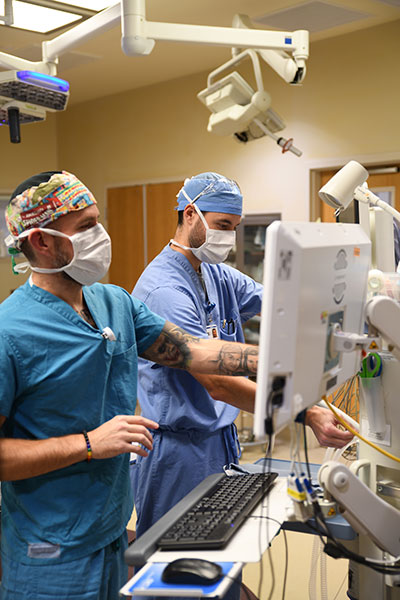
Ryan Wells (left) sets up an anesthesia charting system as Andrew Kochan (right) verifies the anesthesia machine is ready for patients.
When it comes to doing the job as a nurse, there are instances where a male nurse might be more useful than a female and, equally so, female nurses have roles and situations where they are the ones who can deliver the best care and comfort to patients.
“Some patient interactions can go smoother with a male handling it, strictly anecdotal,” said Wells. “There are times with patients, that they don’t respond to the female nurse, they don’t respond to a female doctor. They don’t respond to anyone.
“On the flip side, it helps to have a female in that role, such as in sexual assault cases or with culturally diverse interactions with patients who may not feel comfortable having to undress in front of a man. It helps to be able to be sensitive to and cognizant of those interactions and allow a female nurse to step in and help from there.”
Like the two alumni, Grassie and Samec believe gender doesn’t matter in nursing because men and women are doing the same vital job — providing care to those who need it.
“Traditionally, when people think of nurses, they think of females because they associate the traits of caring and compassion, major aspects of nursing, with females only and not males,” said Grassie. “But I feel if someone is doing something important and meaningful to them, those traits will automatically follow, regardless of gender.”
“In today's society, I don't think there's any profession you can say is strictly male or female,” Samec added.
Regardless, getting a great nursing education begins with The University of Akron.
"UA has a strong lineage of great providers who have shared their expertise and left behind the legacy that still holds the School of Nursing up,” said Kochan. “UA students stand out because of the program and how the education is strong and so is the knowledge base of those who are teaching the up-and-coming students into these professions. They see the importance of passing on their knowledge and I felt that. It was not out of some sort of checkbox; it was from a compassion standpoint. They want to see the end product of UA graduates really excel out in the community. People are finally catching the buzz on what nursing has to offer.”
Story by: Alex Knisely
Media contact: Cristine Boyd, 330-972-6476 or cboyd@uakron.edu
